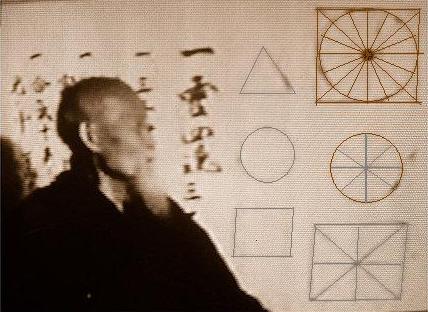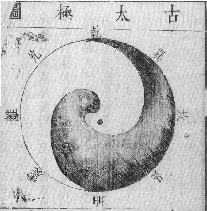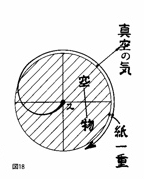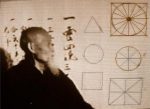
Morihei Ueshiba Lectures
Ichirei Shikon Sangen Hachiriki / 一霊四魂三元八力
In “Kiichi Hogen and the Secret of Aikido” we traced a connection between what Aikido Founder Morihei Ueshiba cites as one of the “Secrets” of Aikido and Chinese military strategy. In “Morihei Ueshiba, Budo and Kamae” we traced a connection between a section of the technical manual “Budo”, published in 1938 by Morihei Ueshiba, and certain very common concepts in Chinese martial arts.
Of course, there’s more, a lot more, threaded all through Morihei Ueshiba’s lectures and essays. Once the connections are laid out I think that this will become clear – even obvious. What will also become clear is the training methodology being laid out, in no uncertain terms, by the Founder.
For a start, Morihei Ueshiba would often say that “Ichirei Shikon Sangen Hachiriki” (“One Spirit, Four Souls, Three Origins, Eight Powers”) represented the basic structure of the Universe, and the basic structure of Aikido.
At the top of this post is a screenshot from a video showing Morihei Ueshiba lecturing on this very concept – you can see “Ichirei Shikon Sangen Hachiriki” (一霊四魂三元八力) written on the board behind him. The diagrams are important too, but I’ll talk about them in a future essay.
Here’s one of the things that Morihei Ueshiba said about “Ichirei Shikon Sangen Hachiriki”:
「合気道とは和合の道であり、即ち一霊四魂三元八力の生ける姿、宇宙経綸の姿、即ち高天原の姿である」
“Aikido is the way of harmony, that is to say the living form of Ichirei Shikon Sangen Hachiriki, the form of the fabric of the universe, specifically the form of the High Plain of Heaven.”
The “High Plain of Heaven” (“Takamagahara”) is the place where the gods were born – Heaven, so to speak. In this case Ueshiba is saying that Ichirei Shikon Sangen Hachiriki is created within yourself, as in this quote from “Takemusu Aiki”, page 77:
タカマガハラも自分にあるのであります。天や地をさがしてもタカマガハラはありません。それが自己のうちにあることを悟ることであります。
“Takamagahara is within yourself. If you search for Takamagahara you will not find it on Heaven or Earth. That is when you will become enlightened to the fact that it exists within yourself.”
In other words, Aikido and Ichrei Shikon Sangen Hachiriki represent both the structure of the Universe and the structure of you yourself as an individual – or perhaps it would be more accurate to say, how you yourself should be constructed physically and mentally in order to attain an ideal state both martially and in life.
Quite a profound concept, if you can manage to wrap your head (and body) around it, I think, and a pretty neat package description of philosophical and technical Aikido.
The first section, “Ichirei Shikon” (“One Spirit, Four Souls”), is the structure of the spirit world. In Shinto cosmology humans possess one spirit and four souls – the turbulent (aramitama), the tranquil (nigimitama), the happy (sakimitama) and the wondrous (kushimitama). The “naohinomitama” is the one spirit that acts as kind of a container for the four souls.
Let’s leave that section aside for another day and concentrate right now on the physical structure of the Universe – and of Aikido technique, which also follows this pattern.
The second section, “Sangen Hachiriki” (“Three Origins, Eight Powers”), is the structure of the physical world, the physical self and the physical training methodology in Aikido.
The first part of that section is the “Sangen” (“Three Origins”), the three basic building blocks of the universe – heaven, earth and man, represented as hard, soft and flowing by the circle, triangle and the square (hence the name Aikido Sangenkai!).
Of course, everybody has seen the circle, triangle and square, but does Heaven-Earth-Man have anything to do with Aikido?
Morihei Ueshiba thought so:
合気道は天地人和合の道と理なり。
“Aikido is the Way and Principle of harmonizing Heaven, Earth and Man.”
Coincidentally (or maybe not so…), one also unifies the Ki from Heaven and Earth with that of Man to form the Taiji, the “Grand Ultimate” in Chinese internal martial arts.
This leads us to a telling quote from Koichi Tohei’s book “気の確立” (“The Establishment of Ki”). It comes in the section where he discusses his break from the Aikikai:
二代道主は、合氣道を「人の気に合わせるの道」と解釈していた。しかし私にしてみれば、合氣道とは「心身を統一して天地と一体になる。すなわち天地の気に合わす道」なのである。
“The second Doshu interpreted Aikido as “the Way of fitting in with another person’s Ki”. However, it seems to me that Aikido is “Uniting body and mind and becoming one with heaven and earth. Specifically, the Way of fitting together the Ki of heaven and earth.”.”
Note that Koichi Tohei’s model follows Morihei Ueshiba’s quoted model, and that he (correctly, in my opinion) states that the process occurs within oneself rather than between oneself and another person – see the quote from Ueshiba on “Takamagahara” above concerning that point.
Whether Tohei correctly represents Kisshomaru Ueshiba’s opinions or not (and the ramifications) we’ll leave for a seperate discussion.
In Chinese cosmology the Universe begins with the Void, represented by an empty circle, the Enso. The void divides into two, the “In” (“Yin”) and “Yo” (“Yang”) opposing powers.
The Enso is often seen in Aikido artwork as well – and Morihei Ueshiba also said that the Circle is the Void. Here is another interesting quotation from Ueshiba:
「合気というものは、初め円を描く。円を描くこと、つまり対象力。相手に指一本ふれないでも相手は跳んでしまう。この一つのものをつくりあげるにも十年ぐらいはかかる。これからは大飛躍をしよう。」
“In this thing called Aiki, first describe (draw) a circle. Drawing a circle is, in other words, opposing powers. Without touching with even one finger your opponent will be sent flying. Just to be able to do this one thing takes about 10 years. Let’s try to advance quickly.”
Opposing powers, “In” and “Yo”, echoes of the same story cited in “Aikido ™ – Can it really be trademarked?” and “Kiichi Hogen and the Secret of Aikido” – when Henry Kono ask O-Sensei “Why can we not do what you do, Sensei?” the answer was quite simply “Because you don’t understand In and Yo.” (from “Aikido Memoirs” by Alan Ruddock).
According to Chinese theories, when the circle (Wuji, the Void) divides in two and is joined by Man you get the “Grand Ultimate” – the basic “In” (“Yin”) and “Yo” (“Yang”) opposing forces divided/united by a curving line represented in the Taiji symbol – Heaven and Earth united/divided by Man.

Diagram of Taiji by Zhang Huang 章潢 (1527-1608)

From “Aikido Shinzui” by Bansen Tanaka (1976)
Note the similarity of the above diagram to the first diagram of the Taiji by Zhang Huang. The above diagram appeared in a privately published work by Bansen Tanaka entitled “Aikido Shinzui” in 1976 (no relation to the later work published by the Aikikai). Bansen Tanaka was a pre-war student (from 1936) of Morihei Ueshiba, and continued to host Ueshiba on his frequent trips to Osaka after the war.
The Kanji at the top right read “The Void”. The Kanji on the bottom right read (“the thickness of a single piece of paper”). The Kanji in the right side of the diagram read “Emptiness” and “Matter” (i.e. “Heaven” and “Earth”).
In the center is the single Katakana character “Yu”, which in Kotodama terms stands for the harmony of Fire and Water (i.e. “In” and “Yo”). It has been pointed out that the character may also by “Su” (I blew it up, but I can’t tell in my scanned copy) – in Ueshiba’s cosmology “Su” pierces the void and moves to “U”, which manifests as the two “In” and “Yo” opposing forces.
See any similarities?
When you see the yin-yang symbol in China it is often surrounded by eight trigrams. These represent the “eight powers” of Chinese internal martial arts, which are the eight different ways that yin and yang interact to create power, or “jin”. This is so important in China that an entire internal martial art (Ba Gua) was actually named after it, and that Taiji was originally known as the “13 Postures” – 8 powers combined with 5 basic directions.
In Morihei Ueshiba’s structure of the Universe the “Hachiriki”, or 8 powers/forces, are an active force, a quiet force, a pulling force, a loosening force, a splitting force, a combining force, a melting force and a congealing force (you can see that each “in” force has a matching “yo” force).
八力は、対照力「動、静、解、凝、引、弛、合、分、」「9-1、8-2、7-3、6-4」をいいます。
“The 8 powers are opposing forces: Movement – Stillness, Melting – Congealing, Pulling – Loosening, Combining – Splitting / 9-1, 8-2, 7-3, 6-4”
You may recognize the numbers from “Kiichi Hogen and the Secret of Aikido“. There’s more on the eight opposing forces and the way that they relate that’s important to Aikido – but we’ll get into that another time.
So now we see that Morihei Ueshiba’s cosmology for the physical structure of the Universe is identical to the Chinese cosmology. Further, we see that Morihei Ueshiba’s structure for the physical manifestation of his art is identical to that used in the Chinese internal martial arts – right down to the terminology.
Here’s a last thought from Morihei Ueshiba:
「一霊四魂三元八力や呼吸、合気の理解なくして合気道を稽古しても合気道の本当の力は出てこないだろう。」
“I think that if you cannot understand Ichirei Shikon Sangen Hachiriki, breath (kokyu) and Aiki, then even if you practice Aikido the true power of Aikido will not come forth.”
Christopher Li – Honolulu, HI







Leave a Reply